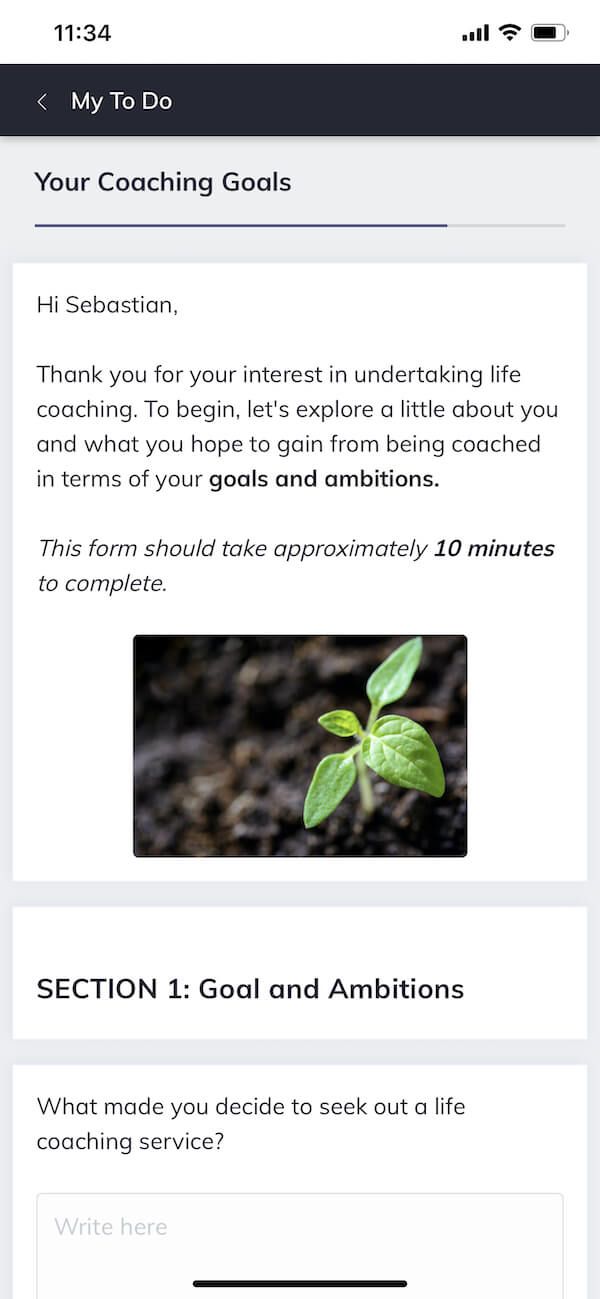28 Coaching Techniques Confident Coaches Use
 While coaching models and frameworks help provide structure to the practice, skilled and confident coaches draw from an arsenal of techniques.
While coaching models and frameworks help provide structure to the practice, skilled and confident coaches draw from an arsenal of techniques.
The most powerful coaches know the value in developing the intuitive, fluid art of using different techniques based on what will be most effective for their desired goal.
In this article, we will touch on some of the most effective techniques used in various styles and formats of coaching, including tips for goal setting, motivation, and life coaching.
Before you read on, we thought you might like to download our three Positive Psychology Exercises for free. These science-based exercises explore fundamental aspects of positive psychology, including strengths, values, and self-compassion, and will give you the tools to enhance the wellbeing of your clients, students, or employees.
This Article Contains:
- 5 Effective Coaching Techniques
- Techniques for Executive and Workplace Coaching
- For Managers and Leaders
- For Job Coaching
- 3 Motivational Techniques
- 3 Group Coaching Techniques
- 3 Life Coaching Techniques
- Techniques for Goal Setting
- A Look at CBT and Behavioral Coaching Techniques
- A Take-Home Message
- References
5 Effective Coaching Techniques
No matter what type of coaching – be it personal or professional – there are specific foundational techniques based mainly around communication and motivation, which all coaches should have in their toolkit.
This article will contain techniques and approaches to various forms of coaching; this first set is more general and can be used in any coaching context.
Below we have hand-selected some of our favorite, proven techniques that you can start implementing with your clients today. This is by no means a definitive list of coaching techniques.
1. Pre-session check-in and questionnaire

This might include something they wanted to tackle during the last session but did not get around to.
This is also an excellent time to have clients list their most significant wins and any clarity they have gained since their last session, helping both the coach and the coachee to recognize where progress has been made.
Equally important, the pre-session check-in should provide space for the client to state what they’ve been struggling with and any roadblocks they’ve been facing.
To gather this information efficiently, coaches are increasingly drawing on digital technologies.
For instance, using a blended care platform such as Quenza (pictured here), coaches can design a simple, standardized questionnaire to send to coachees at the beginning of the coaching relationship.
Using the tool, coaches may also design the check-in surveys mentioned above that allow clients to flag what they’d like to discuss in their next session. These can then be automatically sent to clients’ smartphones according to a pre-programmed schedule (e.g., 24 hours before their next session).
This is just one example of how coaches might use a blended care platform like Quenza as a powerful, automated information-gathering tool across a range of coaching contexts.
2. Centering, breathing, or relaxation exercises
Taking time to get centered and grounded at the start of a coaching session can help bring both the coach and the client into a present and focused state of mind by establishing positive energy before delving into the material of the session.
Science shows that slow, deep breathing stimulates a part of the parasympathetic nervous system called the vagus nerve, which promotes calmness and relaxation (André, 2019). You might be most comfortable using a script to walk your clients through a centering exercise, or you may choose to guide them through one on the spot intuitively.
In addition to using this technique at the start of your meeting, you may also consider pausing for a quick centering exercise during a session, perhaps before tackling a challenging subject, for a break between topics, or to interrupt unhelpful thoughts patterns when the coachee is speaking from a place of fear.
3. Open-ended questioning
Asking open-ended or “guiding” questions is an effective way to assess a client’s wants, needs, and desires, and it is one of the cornerstones of great coaching. Questioning encourages self-reflection and invites the coachee to find the answers they’re seeking within themselves.
As a coach, it’s essential to stay curious and fully present with your line of questioning to select the right question at the right time. Also, remember to allow enough time between asking a question and receiving an answer.
Commonly referred to as the “Socratic method,” this method of questioning named after the early Greek philosopher Socrates is built on the idea that asking guiding questions can unlock underlying beliefs and spark a new level of awareness. We continue to utilize this method today to induce clarity and transformation with our coaching clients.
For in-depth examples of open-ended questions, refer to this article on the 100 Most Powerful Life Coaching Questions.
4. Follow-up for feedback
One of the simplest and most productive techniques a coach can use is ongoing follow-up in between sessions. Follow-up allows the coach to evaluate the effectiveness of the coaching, shows the client that the coach cares about their progress and wellbeing, and also aids in accountability.
Follow-up can come in the form of email, questionnaire, text message, or any other means of communication, and is most helpful if it is consistent. For example, you can regularly follow up with your coachee directly after the session, 24 hours after the session, midway to the next session, etc.
This simple technique of asking for feedback provides invaluable information that aids the coach in preparing for the next steps. Be sure to make it clear to the coachee that there will be no judgment and that honest feedback is in their best interest; it will allow them to get the most out of the coaching experience.
Don’t be afraid to probe deeply, either. Getting useful feedback can be the fastest route to growth and improved performance.
5. Accountability
Accountability is the glue that ties commitment to the result.
Bob Proctor
Accountability helps us to reach our goals, whether it be in the office or at the gym. A study conducted by the American Society of Training and Development found that establishing a goal and planning how you will accomplish that goal results in a success rate of 50%.
With the added variable of committing to someone else to follow through on that goal, it brought the success rate up to 65%. Finally, the participants in the study who planned how they would achieve the goal, made a commitment to someone that they would achieve it, and then set an accountability appointment with that same person reached the target 95% of the time.
In the above example, accountability nearly doubled the odds of participants successfully achieving their goals. There’s no denying the advantage that accountability can increase the odds of achieving a particular goal. As such, it is part of a coach’s job to discover the best way to hold each client accountable.
It’s also the coach’s job to recognize what obstacles might be preventing a client from being held accountable and determine appropriate actions to overcome them.
When implementing the accountability technique, it’s important to be specific, consistent, and make the process as simple as possible. The coach and coachee should work together to create a plan of action with meaningful guidelines and an understanding of how progress will be tracked and how accountability will play out in the relationship.
Techniques for Executive and Workplace Coaching

One of the differences with this type of coaching is that it is usually paid for by the executive’s organization and should, therefore, be conducted within the context of the organization’s goals and objectives.
Executive and workplace coaching can have a profound impact not only on the coachee but on the entire organization. Below we’ll outline a few techniques you can start implementing with your clients today.
Become aware of the larger organizational objective
Executive coaching is driven by specific goals agreed upon by all members of the coaching partnership: the coach, the executive, and the executive’s organization.
For this reason, the goal of developing a single leader should always be pursued within the broader objective of organizational success. At the outset of the coaching relationship, the coach needs to identify these objectives as well as the leader’s own development goals and ensure there are no conflicts.
The coach should maintain continual awareness of the impact of the coaching process on everyone in the system and vice versa, encouraging the executive to see themselves as interdependent with other people and processes in the organization.
Bring awareness to unconscious biases
Unconscious biases are the mental shortcuts that we learn over our lifetime to help us navigate the world. Unfortunately, these biases can have substantial implications when it comes to decision making in leadership.
From recruitment to performance evaluations and promotions, an executive’s tendency to discriminate against a group or type of person may not be intentional. Still, it can severely limit the strategic potential that can flow from a diverse workforce.
To help executives combat unconscious bias, coaches can use bias discovery tools and implicit association tests to uncover ingrained stereotypes and prejudices that may be hindering a client’s leadership performance.
Once biases have been identified, the coach can support the client in reframing and rewiring these biases so that they can operate from a place of higher consciousness.
Define leadership purpose
In the same way that having a sense of purpose in life is important for one’s wellbeing, it can also have a profound effect on one’s professional life. Harvard Business Review asserts that purpose is the key to accelerating executive growth; the processes of articulating one’s leadership purpose and finding the courage to live it are the most important developmental tasks you can undertake as a leader (Craig & Snook, 2014).
Coaching executive clients through writing a personal leadership statement will help them to be more congruent and aligned with their core values and principles. Focusing on the future, determining how and where they want to lead others helps mitigate the risk of getting caught up in the pressures of the present moment and immediate deadlines.
To help clients dig into their purpose, download our three Meaning & Valued Living Exercises Pack here.
For Managers and Leaders

Effective leaders actively take an interest in their employees and help them learn to harness their skills to become more successful.
Approaching management with this type of coaching mindset as opposed to a directive, “I’m the boss” approach can improve employee motivation, performance, and satisfaction levels.
Below are five essential techniques and coaching skills that managers and leaders can start practicing today.
Employee recognition
Leadership requires a balance of criticism and praise. If your conversations with employees are always focused on what’s not working and what they have to improve, it can be very demotivating.
Employees who receive regular recognition show increased productivity and engagement among their colleagues. They also have higher retention rates and get higher loyalty and satisfaction scores from customers (Rath & Clifton, 2004).
There are many creative ways to show employees that you appreciate them. However, a Deloitte study on employee recognition found that three-quarters of people are satisfied with a simple “thank you” for their everyday efforts (Vickberg, Langsett, & Christfort, 2019).
Recognition aids in validating your workforce and helping them connect with a sense of meaning and belonging. It’s a simple technique that results in a friendlier, happier, and more productive environment that will attract and retain the best talent.
Build the relationship
One of the best ways to be able to lead someone better is to truly know them. You can start building a relationship with your employees by asking questions to determine their interests, dreams, strengths and weaknesses, and core values.
This can help you gain insight into what keeps them motivated and focused, and how they make their decisions. Ask for the employee’s view of a particular situation. Do they see the same problem or opportunity that you do? Begin to try to understand their perspective.
Establish genuine trust
Without trust, your employees may not feel confident to share their real thoughts and concerns, and they may not readily accept the feedback you offer them. Establishing genuine trust with them is an essential aspect of improving leadership efforts.
Trust can be built by fostering transparency and creating a nonjudgmental environment, perhaps by having an open-door policy. During discussions, express genuine interest in what they have to say and demonstrate that you are actively listening by giving an accurate summary of what your employee has told you.
Make an effort to show your employees care, consideration, and interest.
Create clear objectives and goals
When a manager and their employees are on the same page in terms of expectations, everyone wins. It’s important for leaders to communicate their vision to employees and explain their role in making it happen.
Goals and objectives convert the overall vision into clearcut, measurable targets, providing employees with direction, helping them stay motivated, and establishing standards of performance.
When employees understand exactly what needs to be done to succeed, it’s much easier for them to contribute.
Motivate
To lead your team to success, one of the best things you can do is learn to understand what truly motivates them. After all, improving motivation at work boosts productivity and workplace morale, and reduces turnover. Since there is no single motivation theory that explains all aspects of human motivation, this can be a daunting task for leaders and managers of any organization.
There are many approaches to employee motivation, and we’ve tackled the subject on the blog many times. Though there is no one-size-fits-all method, leaders will have more success when they approach motivation from the employee’s perspective.
We have an excellent resource on our blog for motivation tools, worksheets, and activities for you to work through. We’ll also take a more in-depth look at motivation techniques later on in this article.
For Job Coaching

As a job coach, you’re likely to draw upon a wide range of skills, including advising, mentoring, and consulting.
You may use some type of psychometric tool to help clients get additional insight into their career preferences or how their personality impacts their career choices. Below we discuss some of the techniques used to assist clients in setting and achieving career goals.
Skills assessment and psychometric profiling tools
Psychometric profiling is a standard and scientific method used to measure individuals’ mental capabilities and behavioral styles, highlighting the dominant general character traits.
Skills assessments can help a job coach identify their clients’ hidden attributes and can be a valuable tool in determining the suitability of a specific career or role.
Such profiling tools are constructed to generate an objective and unbiased report on an individual’s personality, motivations, and interests. They are said to be utilized by over 75% of the Times’ top 100 companies in the UK and by 80% of the Fortune 500 companies in the USA (Allen, 2020).
You can find examples of and content about popular psychometric profiling tools in the following blog posts:
- 7 Most Accurate Character Strengths Assessments and Tests
- Big Five Personality Traits: The OCEAN Model Explained
- 10 Best TED Talks on VIA Character Strengths and Virtues
- Your Ultimate Life Coaching Tools Library
The “perfect day” exercise
The perfect day exercise is a foundational life coaching technique that is intended to provide clarity about what the coachee wants out of life. For those seeking more clarity in terms of their career path, this exercise can be used to determine what one values and prioritizes in their work life.
This technique has been used for years, not only by career counselors and coaches, but recruiters and large organizations as well. Facebook’s recruitment team is likely to ask the following question to candidates in the interview process: “On your very best day at work – the day you come home and think you have the best job in the world – what did you do that day?” (Feloni, 2016).
When using this technique with your clients, ask them to reflect on what they do when they lose track of time at work, which is another way to gauge what they inherently enjoy and are likely good at. Encourage them to be specific and authentic.
Role-playing
As a job coach, you’ll know that the interview process can be one of the most nerve-wracking aspects of a client’s job search. This is where role-playing becomes an effective coaching technique.
To give your clients the chance to practice their interview skills in real life, try setting up a mock interview with questions that will likely be asked by a potential employer. The role-playing technique can also be used for on-the-job scenarios that your client may be having difficulty with. The coach may take on the role of customer, manager, or anyone else in the organization.
3 Motivational Techniques
Motivation is the process that initiates, guides, and maintains goal-oriented behaviors. Understanding motivation is a vital part of any coaching endeavor – a life coach helping a client get motivated to lose weight or an executive coach assisting a leader in staying motivated toward a business objective.
There is ongoing debate concerning whether motivation is primarily the result of internal needs or external goals, as well as the degree to which motivational processes are innate versus learned. The science of motivation is a field of study on its own. In any case, it’s essential to have at least some knowledge of different motivating factors that can be utilized in different situations.
Below we have chosen three of our go-to motivational techniques.
1. Create the right environment
Whatever their priority or goal, make sure the coachee is setting up their environment for success.
If your client wants to go for a jog every morning as soon as they wake up, have them leave their running shoes right beside the bed. That way, as soon as they wake up, they will see the shoes and be motivated to take action.
If your client wants to stop eating junk food, have them remove any temptations from the kitchen.
If your client is trying to write a book, make sure they have a workspace conducive to writing. And so forth. Encourage them to surround themselves with positive people who will support their goal and limit exposure to people who will deter or distract them from their goal.
2. Set goals that are reasonable and achievable
A concept researched and developed by bestselling author James Clear (2016) , says that human beings love challenges, but only if they are within the optimal zone of difficulty.
Coined “The Goldilocks Rule,” Clear asserts that tasks that are significantly below our current abilities are boring, while tasks that are considerably beyond our current capabilities are discouraging. But tasks that are right on the border of success and failure are incredibly motivating to our human brains (Clear, 2016).
Simply put, a consistent finding in motivation science is that one of the best ways to stay motivated is to work on tasks of “just manageable difficulty.” Working with clients to set goals that are reasonable and achievable, then measuring progress and repeating the process, is an effective motivational technique you can start implementing today.
3. Work with momentum
Getting started, even in very small ways, is a form of active inspiration that naturally produces momentum. Often, most of the resistance to a task comes at the beginning, but once started, the progress occurs more readily.
One of the keys to getting motivated is just to make one small change in behavior that can help create the momentum and motivation needed for the bigger changes.
While motivation is about feeling, momentum is about action. A client’s desire and willingness to do something can indeed wane with time. When motivation is lacking, ask your clients, “what is one small action you can work on right now, toward your goal?” Once they pick back up (or get started) with that once simple task, it is likely to be followed by progress and momentum.
You can find more content pertaining to motivation in the following blog posts:
- Self-Determination Theory of Motivation: Why Intrinsic Motivation Matters
- The Science of Improving Motivation at Work
- Self-Motivation Explained + 100 Ways to Motivate Yourself
- 17 Motivation Tools, Worksheets and Activities for You and Your Clients
- How to Motivate Someone, Including Yourself
- What Is Motivation? A Psychologist Explains
3 Group Coaching Techniques

It involves individual members who have their own goals, although members may be in a similar phase or timeframe in their life or business. Sessions can take place in person, over the phone, or via online video conferencing.
As it is merely an extension of the coaching process, you should lead with core competencies such as goal setting, accountability, and communication, while deepening your understanding of key group issues.
Here are some specific group coaching techniques to help form the foundation of your group coaching program.
1. Create shared expectations
Creating shared expectations is important with this format of coaching because it’s possible that you’ll find people with drastically different personalities and thought processes in one group. In your first group session, it is recommended to establish firm guidelines about punctuality, confidentiality, feedback, and general expectations.
From the beginning, you will also want to identify themes and goals that will act as a common ground for bringing together such a diverse group of people.
2. Peer coaching & accountability
A vital part of the coaching process is having clients identify the actions they would like to be accountable for, session to session. In a group setting, it’s a bit more difficult for the coach to maintain that accountability with each individual, week over week.
By assigning everyone to a buddy or facilitating peer coaching within the group, it ensures a built-in accountability mechanism for all participants. Furthermore, when peers of equal status support each other’s journey and goals, it provides an opportunity for both parties to develop their leadership skills.
3. Utilize social networking groups
Utilizing social media platforms to connect group members in between sessions can be a great way to keep participants motivated and inspired. Create an online forum where the group can ask questions, share ideas, give feedback, and best of all, be accountable to one another.
Facebook and WhatsApp groups work well for this sort of thing.
It still remains the coach’s ethical responsibility to maintain the privacy of clients. Connecting on social networks should be optional for clients and based on their comfort level.
3 Life Coaching Techniques
While professional coaching is more geared toward performance, life coaching is generally focused on personal development, wellbeing, and quality of life.
As a coaching professional, you will know that there’s not a generic checklist to be used with all clients. Skilled life coaches can switch between different techniques based on what will be most effective for their client’s desired goal.
The following are just a few essential techniques that can be utilized in conjunction with any of the methods previously mentioned.
1. Journaling
The benefits of journaling (or “expressive writing”) have been increasingly documented in recent years. Stress reduction, increased creativity, and improved clarity are just a few of the mental and emotional benefits of regular journaling.
Simply writing down our thoughts and feelings allows us to process and understand them better. It helps to prioritize problems and fears and identify negative thought patterns and behaviors to be able to recognize triggers.
When our clients experience a “negative” life event, such as losing a job, becoming ill, or getting divorced, it can impact all aspects of their lives. Writing can help them to focus and organize such traumatic experiences.
In addition to being a vital tool in times of stress, journaling can also encourage clients to move toward their goals or dreams. Furthermore, what comes up through the journaling process can provide valuable insights and ideas for the coach to use to probe and push the client further.
Be sure to check out this valuable resource on writing therapy to enhance your personal growth.
2. Mindfulness techniques
Mindfulness is when we purposefully notice what’s happening in this very moment, within and outside of ourselves, and without judgment.
Though meditation is the most powerful way to practice mindfulness, there are many other mindfulness techniques and exercises you can start using with your clients today.
The proven benefits of incorporating mindfulness into our daily lives include improved sleep quality, a better immune system and memory, as well as increased positive emotions and reduced negative emotions and stress. It may be as good as antidepressants at preventing a relapse of depression (Kuyken et al., 2015).
As a therapeutic approach, mindfulness can be used to help solve an array of issues and accomplish many kinds of objectives. If the coachee’s goal is to lose weight, mindful eating trains them to stop eating when they are full and to realize when they’re eating out of boredom versus eating because they’re hungry.
If your client is working on a relationship issue, mindfulness will help them look beyond their automatic judgment and behavior to see, for example, where they may be reacting in haste or not listening to the other person.
Using mindfulness as a coaching technique is as simple as teaching your clients what it means to be mindful and how to implement it in everyday life and use it as a guiding principle.
To meet the rising demand for mindfulness practitioner training, PositivePsychology.com cofounder Dr. Hugo Alberts has created ‘Mindfulness X, an eight-session training package based on scientific research and complete with worksheets and exercises for your clients to use (with white-label rights to use your own branding). If you’re a practitioner who wants to infuse your coaching, therapy, or teaching with mindfulness, we highly suggest this training package.
Be sure to have a look at our extensive range of mindfulness articles.
3. Active listening
The International Coach Federation (2019) lists active listening as one of the core competencies of coaching and defines it as the:
Ability to focus completely on what the client is saying and is not saying, to understand the meaning of what is said in the context of the client’s desires, and to support client self-expression.
The art of active listening in coaching and leadership is essential for engaging and connecting with those we are coaching in a way that enables them to reach their own conclusions and desired goals.
It goes hand-in-hand with open-ended questioning; we fully listen to the client’s answer and then use their own language to reinforce/repeat back what they are saying. This is what is called “level two” listening. Listening at level two includes noticing the tone of voice and body language, and listening for the sole purpose of gathering information for the benefit of someone else other than yourself.
Techniques for Goal Setting

Whether it be a business pursuit or a personal development journey, goal setting is a vital component of any effort to improve.
Achieving goals often has a lot to do with establishing new habits, and it’s not uncommon for people to get overwhelmed and frustrated by this process, focusing too much on making substantial changes rather than on small changes in the here and now.
To avoid these and other common pitfalls, coaches can use some of the following goal-setting techniques to improve the likelihood of their clients achieving their goals.
Goals with intention
While goals are future focused by nature, intentions are rooted in the present moment. The future – full of unknowns – can induce anxiety, whereas the present keeps us grounded.
This is why focusing on the process and small daily intentions can help us avoid getting overwhelmed by ambitious long-term goals. Committing to being intentional about your goals allows you to focus on how you want to be in the moment, irrespective of how close or far you are from reaching the goal at hand.
With this technique, work with your client to create a balance between their desired outcome and their intentions, based on their values and what matters most to them. Goal setting then naturally follows.
Immediate rewards
For many of us pursuing goals, it can be hard to stay consistent when we don’t see immediate results from our behavior change. We’re more likely to stay on track if we make a point of noticing our accomplishments along the way.
A series of research studies were conducted by the University of Chicago to predict adherence to New Year’s resolutions (Woolley & Fishbach, 2017). Woolley & Fishbach (2017) found that while delayed rewards may provide motivation for the pursuit of long-term goals, immediate rewards were more strongly linked with actual persistence in a long-term goal.
Work with your client to identify specific milestones or activities that they can celebrate throughout the process, as well as rewards that excite and motivate them. Rewards can pertain to entertainment, food, self-care, shopping, travel, nature, or anything else that the coachee deems enjoyable.
Work with the science of habits
Accomplishing goals usually involves the creation of new behaviors or habits or the modification of existing ones. According to Stanford professor B. J. Fogg, there is a simple three-step pattern that every habit follows (Clear, 2013).
The 3 Rs of habit change have been proven time and time again by behavioral psychology researchers:
- Reminder (the trigger that initiates the behavior)
- Routine (the behavior itself; the action you take)
- Reward (the benefit you gain from doing the behavior)
According to Duhigg (2014), the key to changing bad habits is to swap out the middle R: routine. Use a current trigger (reminder) and replace the behavior or action that you usually take with the healthier/more positive habit that you’re trying to form. The same applies to adopting a new habit. Select a current trigger and add on a new, specific action to this existing behavior or cue.
For a more in-depth look at goal setting, including exercises, worksheets, and templates, have a look at following blog posts:
- How to Set and Achieve Life Goals the Right Way
- The Science & Psychology of Goal Setting 101
- Goal Setting in Counseling and Therapy
- The Importance, Benefits, and Value of Goal Setting
- 47 Goal-Setting Exercises, Tools, & Games
A Look at CBT and Behavioral Coaching Techniques
Cognitive-Behavioral Therapy (CBT) focuses on exploring relationships among a person’s thoughts, feelings, and behaviors. Therapists work with patients to bring to light unhealthy patterns of thinking and how they may be resulting in self-defeating behaviors and beliefs.
Given its excellent track record for helping patients with depression, anxiety, and other disorders, techniques from CBT are now being used for the general population to help individuals challenge debilitating beliefs and enhance motivation, self-worth, and problem-solving abilities.
Cognitive Behavioral Coaching (CBC) is a fusion of Cognitive Behavioral Therapy, Rational Emotive Therapy, solution-focused approaches, Goal-Setting Theory, and Social Cognitive Theory (Palmer, 2008). Drawing on these evidence-based psychological models, behavioral coaching is a promising form of coaching.
Both CBT and CBC are collaborative and goal oriented, but Cognitive Behavioral Coaching focuses only on the present as a way to change the future. In contrast, Cognitive-Behavioral Therapy also delves into the past and explores pathology to understand the client’s presenting problems.
With CBC, the coach and client work together to identify what is at the root of the client’s difficulty, what might be stopping them from reaching their full potential, and what action is needed to take charge of the situation.
You can find more content pertaining to CBT in the following blog posts:
- CBT’s Cognitive Restructuring (CR) for Tackling Cognitive Distortions
- Cognitive Distortions: When Your Brain Lies to You
- What Is Positive CBT? A Look at Positive Cognitive Behavioral Therapy
- 25 CBT Techniques and Worksheets for Cognitive Behavioral Therapy
You can also download PositivePsychology.com’s three Positive CBT Exercises (PDF) to use with your clients, employees, or students.
So far, cognitive behavioral coaching is still seen as a new and emerging field, with good outcomes in small studies, but it is not well-researched or widely used yet (Lungu et al., 2021).
A Take-Home Message
Within the field of coaching, there are multiple possibilities for specialization. Still, regardless of a coach’s particular niche, most of us share specific techniques for building trust, goal setting, solving problems, and challenging limiting beliefs. The more you practice and the more knowledge you gain about coaching, the better you’ll be at applying the right techniques at the right time.
We hope that you’ve found value in these selected techniques and will use them where you feel it will bring the most benefit to your clients. If you have comments or questions that you’d like to share, please do so in the comments section below.
We hope you enjoyed reading this article. Don’t forget to download our three Positive Psychology Exercises for free.
- Allen, V. (2020, February 12). The top 7 psychometric tools for improving productivity in teams. WorkStyle. Retrieved from https://www.workstyle.io/best-psychometric-tools-teams
- André, C. (2019, January 15). Proper breathing brings better health. Scientific American. Retrieved from https://www.scientificamerican.com/article/proper-breathing-brings-better-health/
- Clear, J. (2013). Transform your habits (2nd ed.). Retrieved from https://jamesclear.com/wp-content/uploads/2013/09/habits-v2.pdf
- Clear, J. (2016, July 19). The Goldilocks rule: How to stay motivated in life and business. Entrepreneur. Retrieved from https://www.entrepreneur.com/article/279109
- Craig, N., & Snook, S. A. (2014). From purpose to impact. Harvard Business Review. Retrieved from https://hbr.org/2014/05/from-purpose-to-impact
- Duhigg, C. (2014). The power of habit: Why we do what we do in life and business. Random House Trade Paperbacks.
- Feloni, R. (2016, February 24). Facebook’s most-asked interview question is tough to answer but a brilliant way to find the perfect fit. Business Insider. Retrieved from https://www.businessinsider.com.au/facebooks-favorite-job-interview-question-2016-2?r=US&IR=T
- International Coach Federation. (2019). ICF core competencies. Retrieved from https://coachingfederation.org/core-competencies
- Kuyken, W., Hayes, R., Barrett, B., Byng, R., Dalgleish, T., Kessler, D., … Byford, S. (2015). Effectiveness and cost-effectiveness of mindfulness-based cognitive therapy compared with maintenance antidepressant treatment in the prevention of depressive relapse or recurrence (PREVENT): A randomised controlled trial. The Lancet, 386(9988), 63–73.
- Lungu, A., Boone, M. S., Chen, S. Y., Chen, C. E. & Walser, R. D. (2021). Effectiveness of a Cognitive Behavioral Coaching Program Delivered via Video in Real World Settings. Telemedicine and e-Health, 27(1), 47-54.
- Palmer, S. (2008). The PRACTICE model of coaching: towards a solution-focused approach. Coaching Psychology International, 1(1), 4–8.
- Rath, T., & Clifton, D. O. (2004). How full is your bucket? Gallup Press.
- Vickberg, S., Langsett, M., & Christfort, K. (2019, June). The practical magic of ‘thank you’: How your people want to be recognized, for what, and by whom. Deloitte Greenhouse.
- Woolley, K., & Fishbach, A. (2017). Immediate rewards predict adherence to long-term goals. Personality and Social Psychology Bulletin, 43(2), 151–162.
Let us know your thoughts
Read other articles by their category
- Body & Brain (49)
- Coaching & Application (57)
- Compassion (26)
- Counseling (51)
- Emotional Intelligence (24)
- Gratitude (18)
- Grief & Bereavement (21)
- Happiness & SWB (40)
- Meaning & Values (26)
- Meditation (20)
- Mindfulness (45)
- Motivation & Goals (45)
- Optimism & Mindset (34)
- Positive CBT (28)
- Positive Communication (20)
- Positive Education (47)
- Positive Emotions (32)
- Positive Leadership (18)
- Positive Parenting (4)
- Positive Psychology (33)
- Positive Workplace (37)
- Productivity (16)
- Relationships (46)
- Resilience & Coping (36)
- Self Awareness (21)
- Self Esteem (37)
- Strengths & Virtues (31)
- Stress & Burnout Prevention (34)
- Theory & Books (46)
- Therapy Exercises (37)
- Types of Therapy (64)





What our readers think
Hi Michelle,
I must say you have covered all the required tips for coaching techniques. As I am a mindset coach, so I have to offer personal development and life coaching tips and have to arrange a seminar, guides for my fellow followers. I remember those initial days of my coaching journey, I was always getting nervous before any meetups. Then I used to practice exercise, meditation for higher self-awakening. I have also tried almost all the things that you have mentioned, and that’s why I said this article is amazing.
Very helpful to all coaches.
Keep the good work up.
Regards.
Hi Michelle, Great materials. I like your advice what might be a good approach when dealing with an executive who is stubborn and rigid in his leadership style. He does not take ownership in his behaviors and see his supervisor and peers responsible for the problems facing him. Even though when he has been given the 360 degree feedback, he is still reluctant to change. It has become a challenge to me whether he is coachable.
Regards
Robin
Congratulations for your article.I t will helped me to focus on several matters that were not so clear to me
Best Regards
Carlos
(Lisbon,Portugal)
Great tips and guidance – thanks!
Need to use some of these techniques to coach a severely perfectionist teenager. Any tips on coaching teenage students? There doesn’t seem to be much out there for coaching this age group.
Hi Katherine,
Glad you found the article useful. You make a great point that there aren’t many resources to help with coaching teenagers, which seems like a shame. I’m going to pass this on to our writing team, and perhaps we’ll prepare a dedicated post on the topic.
– Nicole | Community Manager
Great, great efforts. I took advantage of these great technologies
Many thanks and gratitude to you